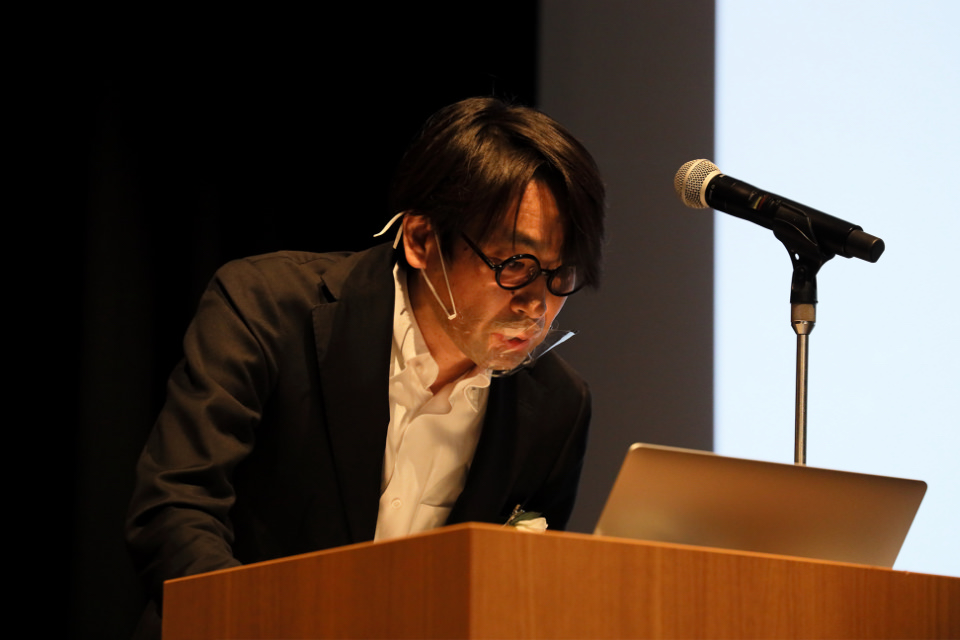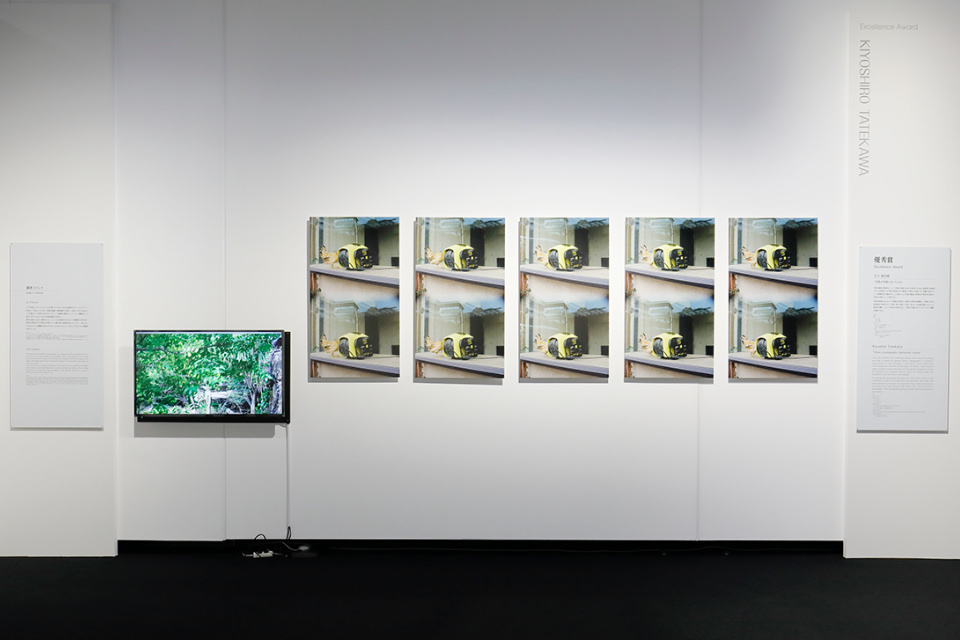PRESENTATION
“When Photography Approaches Itself” is a work that mediates on the differences and boundaries between photos and moving images, while converting photos into moving images and moving images into photos. I created four videos and a book for this work.
The first video work converts photos into moving images and is nine minutes in length. A Cuban filmmaker once said: “Give me two photos, and I'll give you a movie”. When I heard that, I wondered whether I could make a movie from one photo. For this work, I cropped out the bottom third of a vertical photo and slowly moved it upward over a period of three minutes. I also added audio recorded on the spot. I made three patterns, resulting in a nine-minute video.
The second video work also converts photos into moving images and is four minutes long. I used four frames that had been shot continuous with a fixed composition while adjusting the focal point. I added sound to each frame and looped the four frames as set for one minute, allotting one-tenth of a second for each frame. I created four patterns in all — one using two frames, two patterns using four frames each, and one using five frames — to make up the four-minute work.
The third 10-minute video work converts moving images into photos. For this work, I extracted photos from a video, recomposed the photos, and made them into a video again. I took out frames from a 30-fps video and arranged them along a time axis. For the playback, I first had a still image play for five seconds, then five frames of still images cut out at two-thirds of a second intervals, then another still image for five seconds, followed by another five frames. I made three patterns of these playbacks. I used 226 photos for each pattern. This work constantly moves back and forth between moving images and still images.
For the fourth six-minute video, which converts photos into moving images, I used a digital camera equipped with a 3D lens to take continuous bursts of shots of photos with a parallax shift. At first I tried shooting vertically, but the effect was not very interesting. So I tried dividing the shots into top and bottom parts and extracted them separately. I played them back alternately, switching between them every one-tenth of a second, with sound added to each frame. Playing the photos back in this way produced a weird movement. I figured out that the cause of this strange movement was the fact that the subject wasn't stationary but moving.
Finally, the A4 portrait book with 38 pages is a compilation of the photos I used to make the videos.
Everyday life, naturally enough, is in motion. Given this, moving images reflect the ordinary, whereas photos are, conversely, very extraordinary. A world in which motion is suspended felt very fresh and novel to me. What I realized through this work is photos express a world impossible to see with the naked eye. I think that when people saw photos for the very first time, they must have experienced a similar sense of astonishment.
The title “When Photography Approaches Itself” expresses my feeling that I should always approach my works with this sense of astonishment. I hope to think about the astonishment of photographs more consciously in my future works. Of course, I would be very pleased if viewers bring their own interpretations to this work separate from my ideas.


What is your fascination with zoos, even as you change up your methods? In your previous works, you took an approach of waiting for the work to come to you from the images. This time, however, you seem to have been much more hands-on. This feels to me like a huge change for an artist, but what are your thoughts?
(Tatekawa)
I've settled on zoos after shooting all kinds of things. Zoos are profoundly interesting to me because they are spaces that are at once ordinary and extraordinary. It's also fun to shoot videos in a zoo because there is always something happening. Shooting video is like fishing, in that you prepare your gear and then pass the time waiting for something to happen. Later, you turn these happenings into a work of art, rather than a meal. I think zoos are a perfect fit for this kind of “fishing”. I also believe that if I put shots from various places together to make a work, it wouldn't hold together. I can't really explain it, but I believe shooting in zoos gives a work a sense of consistency. This is one of the reasons why I continue to be fascinated with zoos.
As for your second point, it's true that in the past I have often created works based on my interest in what I had shot. This time, however, I reconsidered the relationship between photography and moving images, knowing that this was an entry for the New Cosmos of Photography. And as I thought about this relationship, a simple question arose: Do photographs become a video once they start moving, and do images become photographs once they are clipped out of a video? I wanted to probe this question on a deep level through personal experience, and I think the work expresses this desire in a different way than before.

Judges’s Comment
Yuki Onodera (selector)
I think your presentation would have been improved if you left out the blow-by-blow account of how you made your work. The work is strong enough to stand on its own, and it contains outstanding sensitivity and depth. That's why I feel that it would have been better to have shown more of the work in your presentation.
Your use of gradations was brilliant to connect still images normally connected as frames in a video. Seeing you take the trouble to use gradations in what amounts to a betrayal of moving images and photos — though, in fact, it is no such thing — made me feel that you had conceptually created the work with that in mind. I thought it succeeded visually as well.
What I think is interesting about the relationship between video and photography is that when photography was invented, photography influenced and changed the way paintings were made. In the same way, now that video has become mainstream, video is influencing photography. That's the area my attention was directed towards. Of course, if you continue to create while focusing only on this, your works may become too polished and become predictable. I'd like to hear about what kind of works you have in mind going forward.
(Tatekawa)
At present, I'm making five videos a month and holding screenings, but I would like to create a work that considers video's relationship with photography in the future. I'm also thinking of creating and exhibiting a work in which everything is connected.